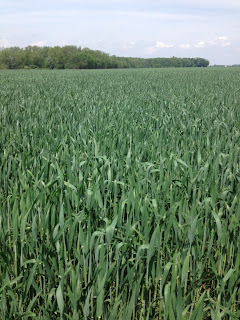A close up picture shows part of the reason why.
These are piles of soybean trash that big dew worms have pulled together over their burrows. These piles of trash are called middens. Under each midden is a hole the size of a pencil.
These holes allow air, water and nutrients to move up and down in the soil profile. Aeration is critical for good plant growth. It is no coincidence that the presence of worms is an indicator of good soil health and crop growth.
Worms will have a very tough time in the type of environment below.
There is no way that worms, or roots, can penetrate soils like this one. You end up with corn that looks like this.
In this particular case we all know that compaction from heavy equipment is the reason. The corn on the right edge of the picture is against the fence line and does not get the wheel traffic. Less wheel traffic means less compaction means better crops. But it is not always easy to identify the reasons for purple or yellow stressed corn.
This one is not as obvious, but the causes are related to past soil management practices.
I believe you always have to think of air. Or more precisely a lack of air. If we could pump some air into the stressed spots they would change for the better literally over night. Which brings me back to my worm friends.
The question is do worms promote soil health or does good soil health promote worms? It is a classic chicken vs egg discussion and in most ways irrelevant. One goes with the other.
My top 4 methods to promote soil and worm health are these.
1.Drainage. Most refuse because the upfront cost is high, but if you own the land the best return on a dollar spent is systematic drainage. Forget the old drains your grandfather put in. Plow in a complete set of new ones. Equipment gets bigger and heavier and the risk of damage increases exponentially with every new combine, grain buggy and manure tanker. Without excellent drainage, dollars spent on all other crop inputs are wasted. Drains pay their way in dry years and wet years. If you consider drains as a crop input, there is no other input that can make the same claim.
2.Manage surface residue. Peter Johnson and Greg Stewart bang away on this for erosion control. I want to add worm health to the list. The big dew worms that do the heavy lifting with respect to aeration are surface feeders. Without surface trash to feed on they starve.
3.Patience. Cathy will tell you I do not possess this ability and she is right. I admire farmers on the heavier soil types who have the fortitude to wait for their soils to dry while all their neighbours are going full blast.
4.Rotation. No need to say any more.
Now that the good corn is growing quickly in the heat it might look like this.
Don't be fooled by the stripes. It is not nutrient deficiency. It is a symptom of rapid growth. The plant is happy and you should be too.
























